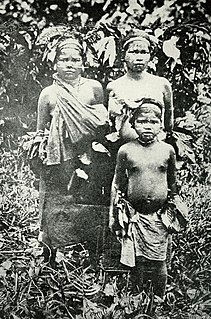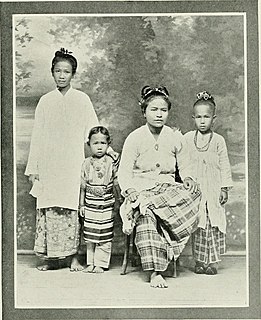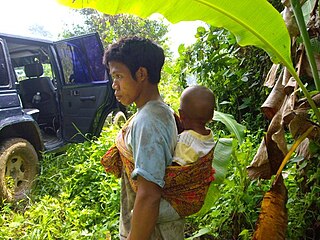
The Semang are an ethnic-minority group of the Malay Peninsula. They are found in mountainous and isolated forest regions of Perak, Pahang, Kelantan and Kedah of Malaysia and the southern provinces of Thailand.

Orang Asli are a heterogeneous indigenous population forming a national minority in Malaysia. They are the oldest inhabitants of Peninsular Malaysia.

Jakun people or Orang Ulu / Orang Hulu are an ethnic group recognised as Orang Asli of the Malay Peninsula in Malaysia.

The Semai are a semi-sedentary ethnic group living in the center of the Malay Peninsula in Southeast Asia, known especially for their nonviolence. They speak Semai, an Austroasiatic language closely related to Temiar, spoken by Temiars nearby. The Semai are bordered by the Temiars to the north and the Jah Hut to the South. The Semai belong to the Senoi group, and are one of the largest indigenous ethnic group in the Peninsula and the largest of the Senoi group. Most Semai subsist by cultivating grain crops, hunting, and fishing.

The Batek people are an indigenous Orang Asli people ; belonging to the Semang group, who live in the rainforest of peninsular Malaysia. As a result of encroachment, they now primarily inhabit the Taman Negara National Park. The Batek are nomadic hunters and gatherers, so the exact location of their settlements change within the general confines of the area that they inhabit.

The Senoi Praaq is a unit of the Royal Malaysia Police made up almost entirely of the tribal people of Peninsular Malaysia known as the Orang Asli (aborigines). The name Senoi Praaq means war people or those who fight in the Semai language. Roy Davis Linville Jumper considered them one of the finest jungle fighting forces and was highly successful in diminishing the threat by communist forces during the Malayan Emergency.

The Mah Meri are an ethnic group native to western part of Peninsular Malaysia. They are one of the 18 Orang Asli groups named by the Malaysian government. They are of the Senoi subgroup. Most of the members of the Mah Meri tribe live along the coast of South Selangor from Sungai Pelek up to Pulau Carey, although there is at least one Mah Meri Community on the other side of the Klang River.

The Malaysian Siamese or Thai Malaysians are an ethnicity or community principally exists in Northern Peninsular Malaysia which is a relatively homogeneous cultural region to Southern Burma and Southern Thailand but was separated by the Anglo-Siamese Treaty of 1909 between the United Kingdom and the Kingdom of Siam. The treaty established the modern Malaysia-Thailand Border which starts from Golok River in Kelantan and ends at Padang Besar in Perlis. In 2014, there were nearly 70,000 people self-identifying as "Siamese" or "Thai" who held Malaysian nationality. This number excludes the senior citizen Siamese who live in Malaysia but do not hold Malaysian citizenship because of political constraint.

The Senoi are a group of Malaysian peoples classified among the Orang Asli, the indigenous peoples of Peninsular Malaysia. They are the most numerous of the Orang Asli and widely distributed across the peninsula. The Senois speak various branches of Aslian languages, which in turn form a branch of Austroasiatic languages. Many of them are also bilingual in the national language, the Malaysian language.

The Temiar are a Senoic group indigenous to the Malay peninsula and one of the largest of the eighteen Orang Asli groups of Malaysia. They reside mainly within Perak, Pahang and Kelantan states. The total ethnic population is estimated at around 32,000, most of which live on the fringes of the rainforest, while a small number have been urbanised.
Orang Kanaq are one of the 18 Orang Asli ethnic groups in Malaysia. They are classified under the Proto-Malay people group, which forms the three major people group of the Orang Asli. The Orang Kanaq are considered as the smallest Orang Asli group with the population of approximately 90 people only.
Jahai (Jehai) is an aboriginal Mon–Khmer language spoken by the Jahai people living in the montane rainforests of northern Peninsular Malaysia and southernmost Thailand. It is the largest Northern Aslian language. Though spoken by only a little more than 1,000 people, Jahai does not appear to be in immediate danger of extinction due to the prevalence of Jahai parents passing on the language to their children as their mother tongue.
The Lanoh are a group classified as "Orang Asli" of the Semang branch by the government of Malaysia. They live in the Malay Peninsula and number around 390. They are also known as Sabub'n or Lano. However, the Lanoh community in Gerik and Lenggong, Perak would identify to themselves as Menik Semnam, a name that refers to the Lanoh people that lived at the Semnam River. Whereas the Malay community in Upper Perak would refer the Lanoh people as Sakai Jeram.
Amani Williams-Hunt bin Abdullah, is a notable indigenous Malaysian social activist, and politician who campaigned for most of his life seeking greater social justice, land rights, and improved life opportunities for Aboriginal Malaysians in Peninsular Malaysia. He is fondly known as Bah Tony amongst the Orang Asli communities throughout the country, is very active in Orang Asli advocacy and was President of Persatuan Orang Asli Semenanjung Malaysia from 1987 to 1991.

Kelantanese Malays are a sub-ethnic group of Malays native to the state of Kelantan, Malaysia as well as in Northern Terengganu. The Kelantanese Malays are closely related to Thai Malays and Terengganuan Malays in neighbouring Terengganu, these two Malay sub-ethnic groups shared historical, cultural and linguistic as well as kinship ties with the Kelantanese Malays. Kelantanese Malays forms 94% of Kelantan's population, which makes them the largest ethnic group in Kelantan and around 150,000 in Besut, Terengganu.

Jah Hut people are one of the Orang Asli tribes living in Pahang, Malaysia. As of 2000, the population of the Jah Hut people are 2,442 and by 2005, it is estimated that there are approximately 4,000 people living in 11 kampungs (villages) that are located along the west bank of the Pahang River from the north in Jerantut to the south in Temerloh, Pahang.

Semelai people are an Orang Asli people of the Proto-Malay people group found in Negeri Sembilan and Pahang states of Malaysia.
Temoq people belong to the Proto-Malay of the Orang Asli ethnic group that are found in Pahang, Malaysia.
Semaq Beri or Semoq Beri people are the native Orang Asli people belonging to the Senoi branch, who live in the states of Pahang and Terengganu in peninsular Malaysia. The Semaq Beri language is a language spoken by the people, is an Austroasiatic language that belongs to the Southern grouping of the branch of Aslian languages.

Cheq Wong people are an indigenous Orang Asli people of the Senoi branch in Peninsular Malaysia. Although they have the physical appearance of the Senoi sub-group, the Cheq Wong language that they speak is closely related to the Northern Aslian languages.















